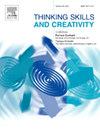运用叙事文本提高小学教师提出问题的技巧
IF 4.5
2区 教育学
Q1 Social Sciences
引用次数: 0
摘要
本研究旨在透过叙事文本,提高小学教师的数学问题提出技巧。本研究采用解释混合法设计。本研究的定量数据来自于在Trabzon工作的24名小学教师,定性数据来自于随机抽取的10名小学教师。为了提高小学教师的问题提出技能,本研究利用web2.0工具,对小学教师进行了问题提出、思维与智力游戏、对话阅读、STEM、儿童哲学、定向运动、博物馆教育、动画创作等方面的理论教育(每项活动3课时),每天6课时,为期4天。参与者被要求从叙事文本“治疗不快乐”中构建问题,作为前测试和后测试。此外,对参与者进行了半结构化访谈,以确定他们对问题提出的想法。通过Wilcoxon rank sign检验,教师在测试后构建的数学内容链、问题类型和问题总数与测试前相比,在统计学上显著增加。对教师的半结构化访谈进行描述性分析。对教师进行基于叙事性文本的问题提出培训,发现教师的非常规问题提出技能有所提高,尽管教师提出的问题数量和他们提出的常规问题数量有统计学上的显著减少。在培训前表示问题提出不足的教师表示,使用叙事文本的问题提出培训提高了他们的问题提出意识。本文章由计算机程序翻译,如有差异,请以英文原文为准。
Improving primary school teachers’ problem-posing skills by using narrative texts
The aim of the study is to improve primary school teachers' mathematical problem-posing skills by using narrative texts. The explanatory mixed-method design was utilized in the study. While the quantitative data of the research were collected from 24 primary school teachers working in Trabzon, the qualitative data were obtained from 10 of these primary school teachers who were randomly selected. In the study, in order to improve the problem-posing skills of primary school teachers by using narrative texts, the teachers were given theoretical information about problem-posing, mind and intelligence games, dialogic reading, STEM, philosophy for children, orienteering, museum education, and animation creation with the help of Web 2.0 tools (each activity took three class hours) for six class hours a day for four days. The participants were asked to construct problems from the narrative text “The Cure for Unhappiness” as a pre- and post-test. In addition, semi-structured interviews were conducted with the participants to determine their thoughts on problem-posing. The Wilcoxon Ranked Signs test was conducted to determine the statistically significant increase in the mathematics content strand, type, and total number of problems that the teachers constructed in the post-test compared to the pre-test. The semi-structured interviews with the teachers were analyzed with descriptive analysis. The training on narrative-text-based problem-posing given to the teachers was found to increase their non-routine problem-posing skills, although there was a statistically significant decrease in the number of problems posed by the teachers and the number of routine problems they posed. The teachers, who stated that they were inadequate in problem-posing before the training, stated that the problem-posing training using narrative texts increased their problem-posing awareness.
求助全文
通过发布文献求助,成功后即可免费获取论文全文。
去求助
来源期刊

Thinking Skills and Creativity
EDUCATION & EDUCATIONAL RESEARCH-
CiteScore
6.40
自引率
16.20%
发文量
172
审稿时长
76 days
期刊介绍:
Thinking Skills and Creativity is a new journal providing a peer-reviewed forum for communication and debate for the community of researchers interested in teaching for thinking and creativity. Papers may represent a variety of theoretical perspectives and methodological approaches and may relate to any age level in a diversity of settings: formal and informal, education and work-based.
 求助内容:
求助内容: 应助结果提醒方式:
应助结果提醒方式:


